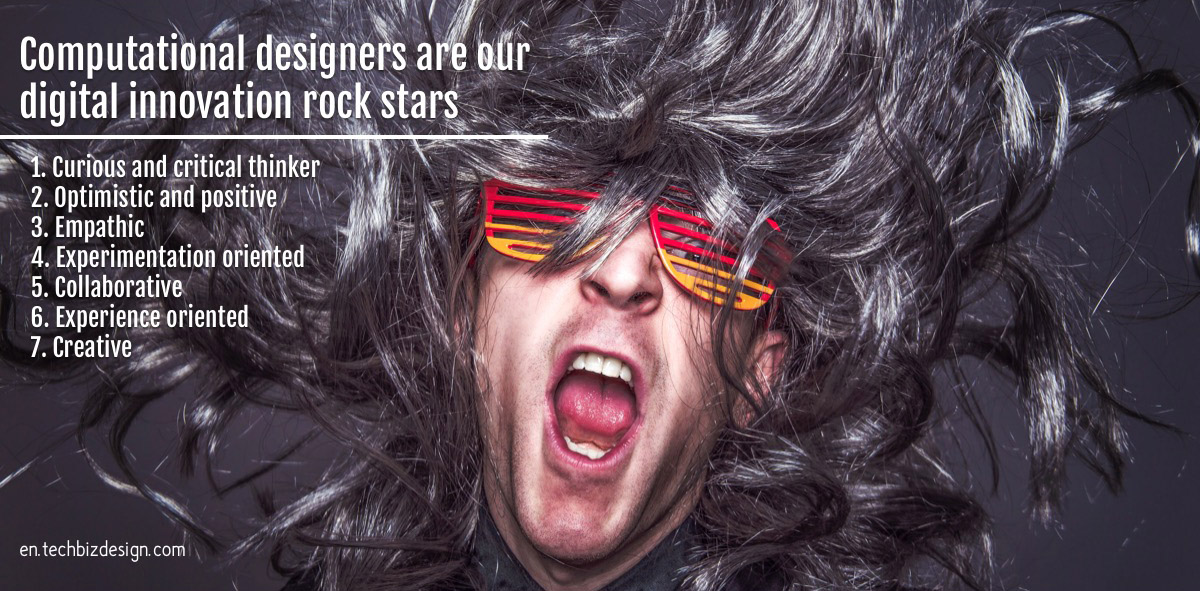THE COMPUTATIONAL DESIGNER MENTALITY
The “value” I’m referring is often called as "professional skills". There’s a huge amount of literature on this concept, specifically oriented to the software industry and all its flavors but also about which are the ones any leader should have, which are the necessary to our self-development, their evaluation and many other things. But today my interest is to know what are those that make up the people, teams or organizations MENTALITY that are building and managing these quality products and, in addition, they get their customers buy them with a smile in the mouth.
Thus, there are 7 basic characteristics that distinguish them. These are: in the first place, a mixture of curiosity and critical thinking. It would be a continuum "What if?". I think the most accurate representation of this feature would be a room full of people working on various ideas and alternatives. A room without discussions but on the contrary, where each new contribution could be followed by a positive contribution like "Yes, and…". A room where closed and unfounded opinions like "The customer will never buy that" or "This will never be approved" or, the one I like most, "There’s no budget for this kind of shit". It’s the continuous search for the limits or what in “modern” language we would call "going out of the box" and being unusual (link).
The second one would be optimism or positivism. This is not about being plugged in and fooling yourself with large doses of coffee and narcotics. We are talking about being able to discover the difficulties and counter them with new opportunities with our feet on the ground but always with the right attitude that allows us to move forward. I do not talk about reaching something unfailingly, because that is the goal. I’m speaking about going ahead in the process, including when go ahead may mean concluding that there’s no viable product. However, this is a topic (link) I've written on my blog more than once.
Closely related to the above topic is the capacity for experimentation. We must pursue being good by materializing ideas in prototypes, not just being skillful. We must always have the need to become things tangible and, if possible, doing step by step. I’m saying this to counteract the usual pressing need to create a prototype to cover everything. It’s better to face bite to bite. Sure your stomach and your product will show gratitude for that.
A key point here is how to manage the fear of failure and frustration. We all know the managers and senior entrepreneurs’ obsession in failing fast and cheap. And it seems logical since we are talking about innovating, experimenting, prototyping ... but failure and criticism sucks. And, although it’s inherent to the process, it’s not pleasant at all for the one who tries it and is very distressing for the management level who always expect great results from the innovation process.
Another key capability is empathy. We are referring here to being human. Having good indicators of customer satisfaction does not mean having empathy. It’s a question of understanding if what we’re proposing as an initiative covers a real customer need or, as often happens, is the projection of some vanity well placed in the organization or with a lot of money to invest.
It’s equally crucial to be able to verbalize this empathy in the way the rest can understand the inputs and work with them. I will never be tired of saying that the user should always be at the center of the whole process, but in this sense it’s important to be aware that there are other valuable sources of information beyond it, both within organizations (call center, salesmen ...) and out of them. We must learn to work with these sources to adapt the empathy to the real customer needs.
Collaboration is another mentality’s key aspect. Today there are multiple channels that allow collaborative work anywhere with any device. But do you think these advances are really helping us in the entire process? To be all equally plugged and in the same mood? Wait a sec…. Who does not remember the University projects in which a few really worked and the others, hopefully, watched from the distance until the end of the course? Here unfortunately we don’t talk about grades at the end of the year. We’re talking about our subsistence as a professional or company. And without collaboration there’s no possible success.
In the same way it should be remembered that teams are usually multidisciplinary, configured by different profiles, roles, egos or responsibilities. Sure that means having endurance. The boring guy that is always talking about the same topics and doesn’t allow to advance in the process… Do you corner it or try to put in? A winning mentality oriented to create your desired products, agglutinates all opinions even when that means a greater integration effort. The results are often surprising and really deserve it.
Another important capacity is the orientation to the experience. It’s about seeing the forest and not concentrating on the trees. It’s a question of being able to think beyond a concrete problem to embrace all the user experience around him. Perhaps, a change of perspective far from the supposed problem source, is believed to have a huge impact on how customers perceive the service or product. A mentality that is too focused on what we already know, that never leave his “comfort zone” where it feels comfortable or that always falling in the same assumptions, will never allow us to become aware of the real problems. If you always do the same, you will always obtain the same conclusions.
And last but not least, we find creativity. It is a no-brainer to say that to get a successful product we must pull creativity. But that’s unfortunately not happening. People dedicated to the creation process don’t have enough time and space to act in the open mode what is the primeval broth of any idea. The results pressure doesn’t allow it.
Having this mentality and, consequently, those competences is a necessary but not sufficient condition. If we want to materialize and bring to the market quality digital products, we must now focus on the practical part of the process which must ensure we can make it happen. To do this, we’ll return to the human lasting health triangle I mentioned at the beginning.









